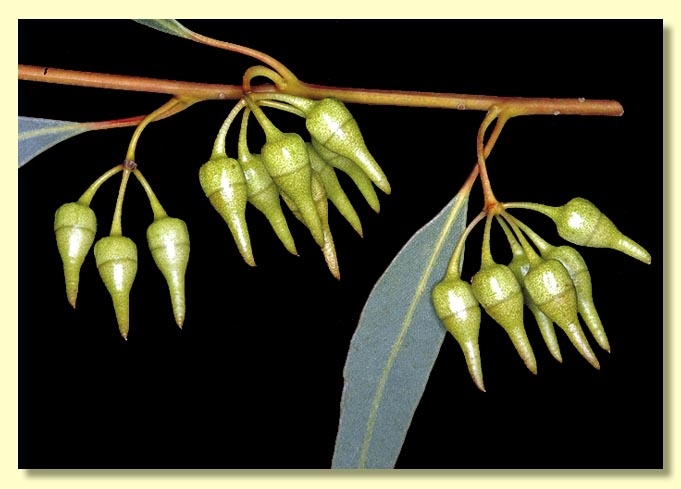Euclid - Online edition
Eucalyptus ecostata
Eucalyptus | Symphyomyrtus | Bisectae | Destitutae | Falcatae | Rugatae
Eucalyptus ecostata (Maiden) D.Nicolle & M.E.French, Nuytsia 22: 428 (2012).
Eucalyptus falcata var. ecostata Maiden, Journal of the Natural History & Science Society of Western Australia 3(2) 173 (1911). T: Hopetoun, Western Australia, November 1909, J.H.Maiden s.n.; lecto: NSW; iso: G, K, L, M, PERTH (images seen of all).
Mallee to 5 m tall. Forming a lignotuber.
Bark smooth throughout, silvery grey and cream-grey over pale brown-orange.
Branchlets lacking oil glands in the pith.
Juvenile growth (coppice or field seedlings to 50 cm): stems rounded in cross-section; juvenile leaves always petiolate, opposite for several nodes but soon alternate, ovate, ca 3.5–6 cm long, 2–3 cm wide, green or grey-green.
Adult leaves alternate, petioles 1–2 cm long; blade narrowly lanceolate to falcate, 7–8.3 cm long, 1.3–2.4 cm wide, base tapering to petiole, margin entire, apex pointed, concolorous, maturing glossy dark green, side-veins usually at an acute angle to midrib, reticulation dense, intramarginal vein close to margin, oil glands intersectional or fairly obscure.
Inflorescence axillary unbranched, peduncles slender and pendulous, 0.6–1.4 cm long, buds 11 to 15 per umbel, on slender pedicels 0.4–1 cm long sharply defined relative to the truncate base of bud. Mature buds ovoid, 1.3–2 cm long, 0.4–0.6 cm wide, the operculum 2.5 to 5 times the length of the hypanthium which tapers very little below the join, and is not or scarcely ribbed, scar present (outer operculum lost early), operculum long conical to quite elongated and not ribbed, stamens inflexed, anthers cuboid, versatile, sub-basifixed, dehiscing by longitudinal slits, style long and straight, stigma blunt, locules 3 or 4, the placentae each with 4 vertical rows of ovules. Flowers creamy white or rarely yellowish.
Fruit pendulous, pedicellate (pedicels 0.3–1 cm long), truncate-globose to hemispherical, 0.5–0.9(1.2) cm long, 0.6–1(1.2) cm wide, usually not ribbed, disc descending or level, valves 3 or 4, slender and prominently exserted but fragile and easily lost.
Seeds dark grey-brown to brown, 1.2–2 mm long, ovoid or flattened-ovoid, dorsal surface smooth to very shallowly reticulate, hilum ventral.
Cultivated seedlings (measured at node 10): cotyledons Y-shaped (bisected); stems rounded in cross-section; leaves opposite for at least 12 nodes, sessile at first, becoming shortly petiolate, initially linear then elliptical for ca 7 to 12 nodes when they become ovate-elliptical, 3–5 cm long, 2–3.2 cm wide, base tapering to rounded, margin entire, apex rounded to acute, green to grey-green, dull.
Flowering has been recorded in October and November.
A mallee endemic to Western Australia, found in the southern coastal and subcoastal regions from the Stirling Ranges and Ravensthorpe Range south to Jerramungup and Hopetoun, and east as far as Munglinup and Shoal Cape. The bark is smooth and the adult leaves glossy dark green, with pendulous umbels of elongated ovoid smooth buds on slender pedicels.
In his classification of the eucalypts Brooker (2000) placed Eucalyptus ecostata (as E. falcata) in in Eucalyptus subgenus Symphyomyrtus section Bisectae subsection Destitutae because buds have two opercula, cotyledons are Y-shaped and branchlets lack oil glands in the pith. Within this subsection E. ecostata belongs to a group of species and subspecies characterised by down-turned or spreading inflorescences with pedicellate ovoid buds with a conical to beaked operculum, flattened to-truncate globose fruits with exserted fragile valves, and adult leaves that are green, densely reticulate and have numerous intersectional oil glands. This group, series Falcatae subseries Rugatae, has been considerably modified since Brooker's published classification. The species now included in subseries Rugatae are: the mallets E. falcata, E. ornata, E. purpurata, E. recta, E. rugulata and the recently described E. annettae, and the mallees E. dorrienii, E. petrensis, E. opimiflora, E. ecostata, plus E. goniantha (with 2 subspecies), E. semiglobosa, E. notactites, and E. kessellii (with 2 subspecies).
Within subseries Rugatae the mallee E. ecostata differs from the mallet species mentioned above by its profoundly different growth habit.
Of the mallee species in subseries Rugatae, E. petrensis, a sprawling mallee, differs from E. ecostata in having spreading to erect, not pendulous, inflorescences with shorter pedicels and peduncles, a more beaked operculum and a restricted habitat on outcropping coastal limestone from Seabird south to Mandurah. The newly described mallee E. opimiflora, which occurs in the northern and central wheatbelt from Mingenew south to Cunderdin, differs from E. ecostata in having smaller umbels on short spreading peduncles, shortly pedicellate weakly ribbed to smooth stout buds and fruit. In the southern wheatbelt and adjacent foothills the mallee E. dorrienii occurs usually on rising ground and is the most similar species to E. ecostata, but differs in having buds visibly ribbed basally on the slightly dilated hypanthium and on the fruit, and buds a bit constricted at the join of operculum and hypanthium (not constriced in E. ecostata ).
The remaining mallee species in subseries Rugatae all occur in southern coastal or subcoastal areas, and differ from E. ecostata thus: E. goniantha (squared branchlets, flat peduncles, stout cream ovoid buds which are weakly ribbed or not ribbed, in 7s or 9s), E. notactites (squared or winged branchlets, flat peduncles, stout cream ovoid buds weakly ribbed, in 7s up to 19s), E. kessellii (broad flat short peduncles, stout cream ovoid ribbed buds in 3s or 7s), E. semiglobosa (pendulous umbels on slender scarcely flattened peduncles, cream rounded buds with rounded short operculum, not or weakly ribbed, in 7s, 9s or 11s). The more distantly related coastal mallee E. cooperiana has spreading or pendulous slender peduncles, white ovoid-cylindrical buds with short usually flattish operculum, unribbed or only weakly so, in 9s, 11s or 13s.
Eucalyptus ecostata: from Latin, e- meaning out of, -costate having ribs, i.e. no longer having ribs, referring to the buds and fruit.







